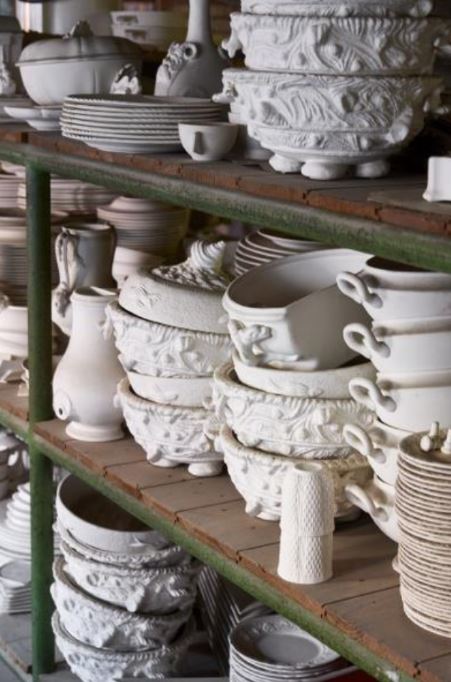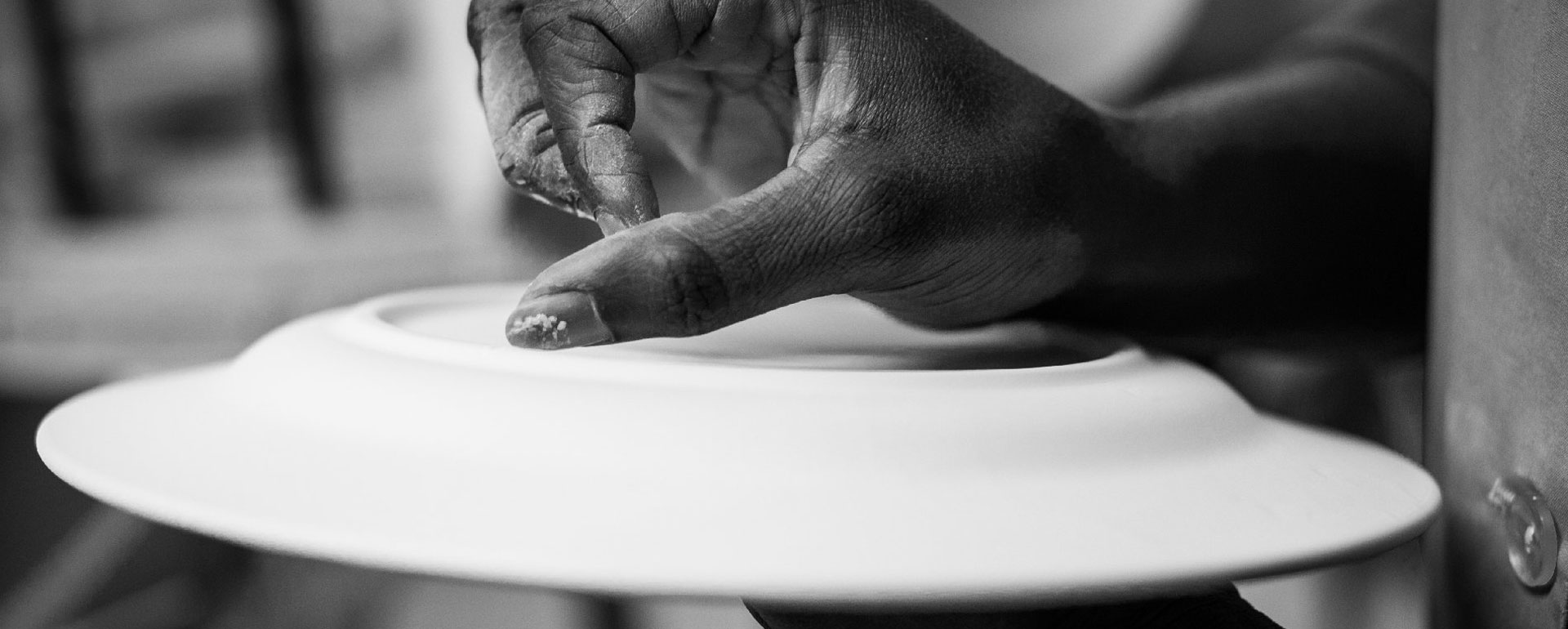
USE & CARE
Part I - Use and Care recommendations
- Household appliances
- Washing
- Handling
Special tips for hotels and restaurants
- Washing tips
- Plate warmers
- Handling
Accessories
- 100% cotton textiles
- Acrylic trays and laminated wood coasters
- Stoneware baking dishes
Partie II - Properties of earthenware
Composition of earthenware
Molding
Shape irregularity
Glazing
Pattern variations
Product sorting standards
Conclusion
LGlossary
Partie I - Use and care recommendations
Earthenware is renowned for its refinement and you might think it is easily breakable, but in fact it is strong ! However, it is sensitive to knocks and temperature variations, and so it has to be handled with care. We do not have a repairs department but should an unfortunate incident occur with your Gien, rest assured that most patterns are produced over a period of years and replacement pieces can be purchased individually.
Gien earthenware is just as elegant and high quality as it is easy to use daily. When care is taken in handling your pieces and understanding best practices, it is possible to get use out of them for decades. Some services ordered in the 19th century are still in use today in many families.
▪ Household appliances: The main thing is to avoid thermal shocks which can potentially damage your pieces, (for example, washing a plate fresh out of the refrigerator in hot water). Earthenware is a porous substance and contains air, because of this it can absorb moisture. In the event of thermal shock, these two components can become unsettled and can cause the glaze structure to weaken, hence causing the earthenware to craze and at length, to crack.
- Microwaving is not recommended as there is a high risk of thermal shock. If you are sure that your earthenware has not absorbed any moisture and you want to use the microwave, use it only on a short re-heating programme. Never use it to defrost or cook food.
- Never use your earthenware for cooking or baking in an oven. We have a range of stoneware goods available and specially adapted to this purpose.
- Earthenware is refrigerator safe. To avoid thermal shock, it must not be subjected to heat on removal from the refrigerator.
- Earthenware is not freezer safe, as defrosting would cause thermal shock.
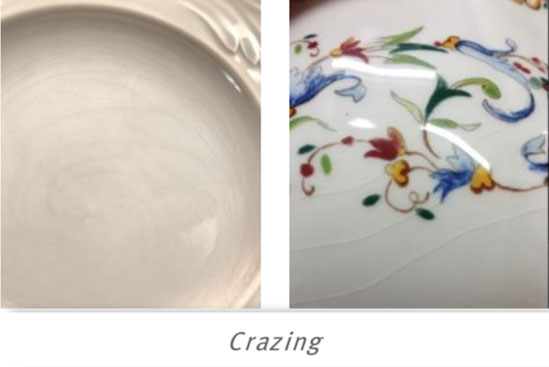
▪ Washing :
- You can wash your earthenware pieces by hand, using a standard sponge and washing-up liquid. NB. do not use steel sponges or steel wool.
- Your earthenware is also dishwasher safe in a home use capacity. Choose a low temperature programme and do not exceed the washing product recommended dosage. Make sure your pieces of earthenware do not touch other pieces in the dishwasher. Warning : gold decorated pieces must not be washed in the dishwasher (details in gold are fired at a lower temperature and are thus less sealed in the glaze and therefore fragile).
- Gien patterns are permanent, they will not fade with time. Avoid, however, leaving greasy or acidic preparations (marinade, salad dressing...) on your earthenware pieces after a meal. Rinse them under warm water after clearing the table so that these substances don’t have time to permeate the non-glazed base of plates in the pile. It is not advisable to soak your earthenware : heat and moisture absorbed through the base will lead, at length, to crazing. Moreover, infiltration of greasy substances may create stains beneath the glaze.
- Note concerning tea pots and tea cups : tea is notable for its staining quality, so we recommend you do not leave tea dregs too long in these pieces. It is advisable to wash them soon after use. It is also advisable to make sure the unglazed base of the cup does not stand too long in tea accidentally spilt into the saucer. To remove tea stains you can use a water and bleach solution.
- We advise you to wipe each piece dry after washing, using a soft dry cloth, to maintain the bright shine and patterns of your earthenware, as hard water may, over time, leave a light pale film of scale on your tableware. Wiping also ensures the plate’s unglazed base is dried, as this, in spite of having been coated with water repellant, can be an entry point for moisture.
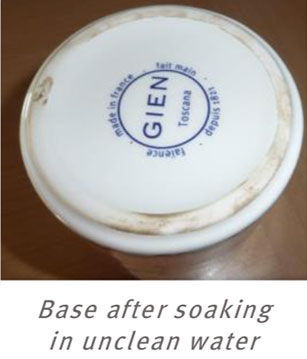
▪ Handling :
- Earthenware is sensitive to knocks, so handle your pieces with care. Corners are particularly sensitive places so avoid knocking them.
- We advise you to stack your plates with care and if possible, place a piece of soft fabric or foam in between each piece, when you put them away. This will protect the glaze from micro-scratches that could be caused by the unglazed underside of the upper plate, and protect the rim from knocks.
- We advise against using ceramic cutlery or utensils that may damage the glaze on your earthenware goods. Furthermore, using certain cutlery or utensils may leave gray traces on the glaze surface. These can be removed using a water and bleach solution. We also advise against cutlery clashing with your earthenware as this might create fragility (e.g. hitting the lip of a cup with a spoon, tossing keys into a letter tray, etc.)
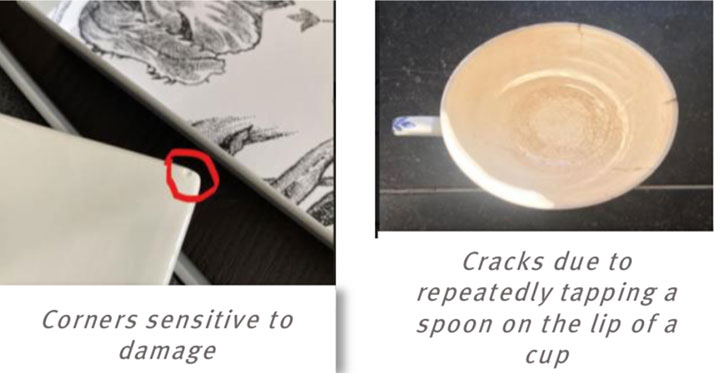
Special tips for hotels and restaurants
For some years now the trend in warm and colorful tables has led many restaurants to choose Gien earthenware. Thanks to our glazing techniques and the presence of feldspar in our clay slip, our earthenware is more resistant than classic earthenware and can therefore be used in restaurants. It must simply be handled with care. Warning : gold decorated pieces are not adapted to intensive hotel/restaurant use.
▪ Washing tips :
- Washing by hand does not require a specific cleaning product.
- Restaurant machine washing is possible, but verify cleaning and rinsing product dosage and settings with your supplier. Very short and hot washing cycles can present a risk of damage because of potential thermal shocks.
- Earthenware can also be prey to acid damage in the shape of salad dressings, lemon, fruits or sauces. After clearing away plates, any residual food traces must be quickly rinsed under warm water (we advise against soaking).
- Special attention must be paid to handling your earthenware, it must be manipulated gently, particularly when plates are being cleared away and washed.
- If the unglazed underside of a plate shows staining, this can be removed using a bleach and water solution.
▪ Plate warmers :
- Plates can be kept warm using a plate warmer or a heat lamp. Take care to avoid thermal shocks (place plates that are already at room temperature in the plate warmer). Plates must not come into direct contact with the source of heat. The heat must circulate and spread in the atmosphere.
▪ Handling :
- In order to get the longest use from your tableware, make sure it is handled with care : carry it in small loads, avoid plates clattering against each other and keep them from chaffing, especially when stacking them. We advise you to stow them in piles that are not too high (about 20 plates), with perhaps a sheet of soft fabric or foam between each plate.
- We do not recommend the use of ceramic cutlery or utensils with our earthenware. Moreover, using certain cutlery or utensils may leave gray traces on the glaze surface. These can be removed using a water and bleach solution.
Accessories
▪ 100% cotton textiles :
- Machine wash at 40°C, using preferably a special detergent for colors
- Can be tumble dried, on a moderate cycle
- Do not bleach
- Use a cool to moderate iron and iron inside out, to protect colors
- Can be dry cleaned
▪ Acrylic trays and laminated wood coasters
- Under no circumstances should the acrylic tray be put in the dishwasher. This will weaken the tray and cause it to deteriorate. We recommend cleaning it with a damp cloth but never with water.
▪ Stoneware baking dishes:
- Oven safe.
- Avoid thermal shocks (e.g. placing a dish fresh out of the oven onto a cold marble top)
- Dishwasher safe, can be soaked in the event of stubborn stains
- Handle with care to avoid chipping
Partie II - Properties of earthenware
Certain traces or marks left during production are evidence that each piece has been made by hand.
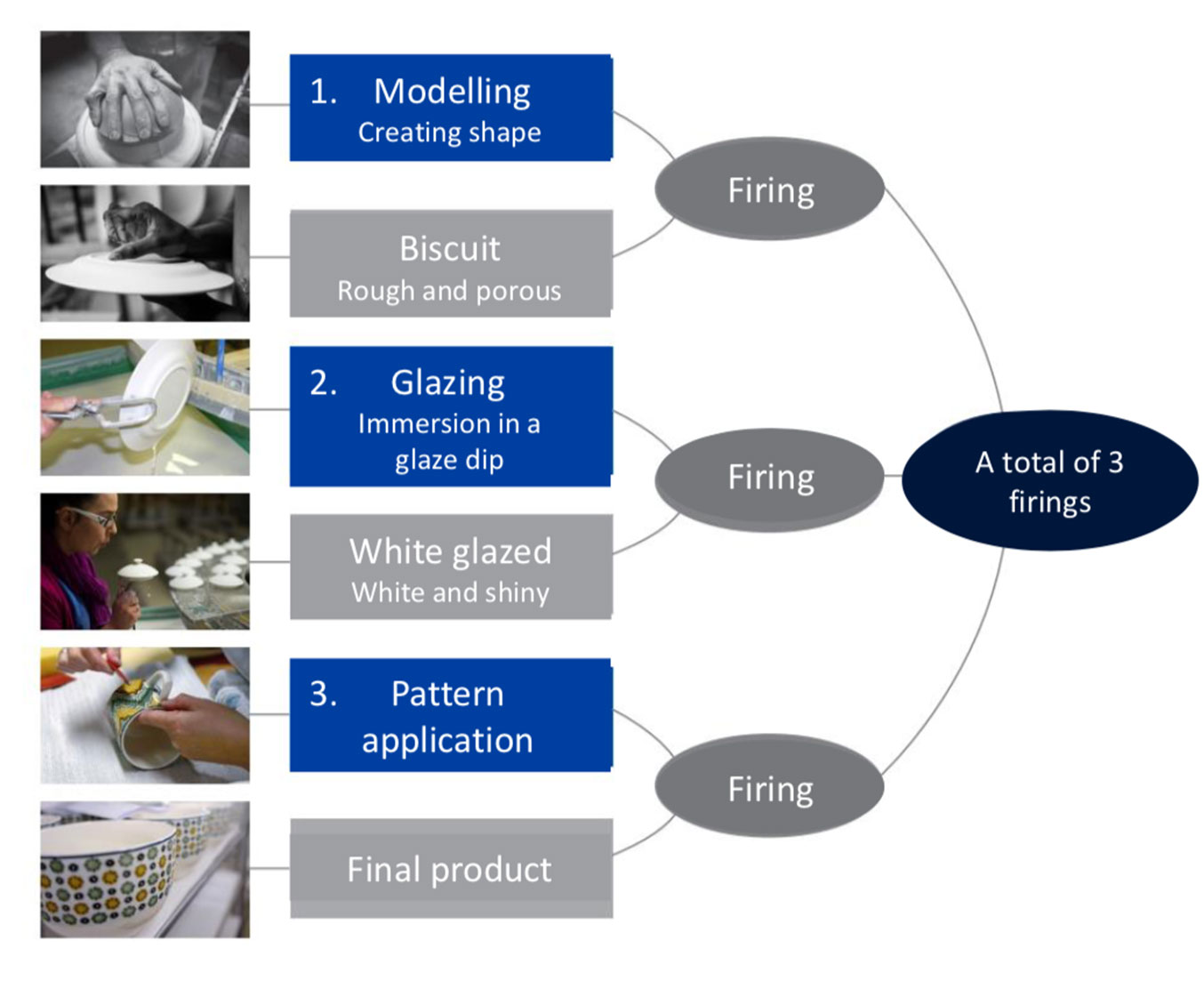
Composition of earthenware
In Gien, earthenware is clay paste of a very fine, dense texture, with a ring to it. This paste is made from clays, kaolin and sands. These ingredients are all diluted in water and ground to blend, then sifted and filtered to produce what is known as slip. Slip can then either be cast in liquid form, for round, hollow shapes, or deaerated then pugged to be extruded in coil form, for molding flat shapes.
▪ These ingredients lend Gien earthenware its singular soft and natural color, they are what make it so vibrant, warm and sensual.
▪ It is also this recipe that gives the clay paste its pigmentation. This can be characterized by minute dark pinpoints on the glazed piece.
▪ Earthenware is porous. This is one of its fundamental features that sets it apart from other ceramics such as porcelain. It means that water can spread through the biscuit if it enters. This is why we glaze and waterproof our pieces.

Molding
There are 3 types of molding methods at Gien:
- traditional clay slip casting, by hand, for round, hollow pieces (teapot, vase...);
- pressure clay slip casting, for cups/mugs and flat non circular pieces (oblong cake tray, letter tray...);
- calibrating clay disks cut from coils, for plates and other circular forms, as well as bowls, cups and salad bowls.
▪ On all pieces cast using the pressure casting method, the trace of the feeder is visible at the base. This is the point of entry where clay slip is injected.
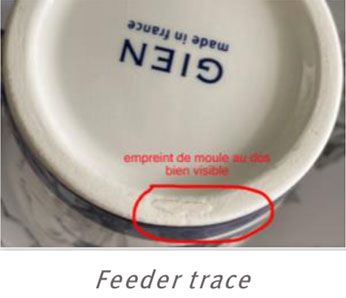
Shape irregularity
▪ Clay paste has a tendency to remember things. All the steps it is put through in the making process are visible when it comes to firing. For example, if a piece had been demolded and set down at an angle that is not perfectly vertical, this will show up after firing. This is the challenge facing our expert craftsmen and women.
▪ Handles and lid knobs are applied to pieces by hand. This means that there may be the slightest variation in their positioning.
▪ There also comes into play a natural occurrence with ceramics known as “shrinkage”. Shrinkage first happens during drying (withdrawal of water during the casting process), and happens again during firing (clay paste ingredients are transformed, under intense heat, contracting and bonding together). When a piece exits the kiln as biscuit, it is smaller than it was on entering, and this is its final form.
▪ We have an inhouse modelling workshop. Our molds are made to be used a certain number of times, therefore any wear and tear they sustain may possibly show slightly on pieces molded in relief (e.g. rice grain feature). Precision of features in relief is more or less sharp, depending on how long or short a time the mold has been in service.

Glazing
This operation is performed by hand, dipping into a tub of liquid glaze. Glaze is a chemical mixture in the form of a suspension composed of finely ground glass frit and water. The dipping action must be measured and brisk in order to ensure regular coating. The porous biscuit absorbs the water leaving the glaze on its surface. When it is fired it then becomes coated in a transparent sheen, vitrified.
▪ Pieces are dipped in glaze then placed on a turntable. This leaves contact traces on the pieces, which are then rectified by hand with a paintbrush. This can lead to a tiny build up of glaze deposit, or conversely, a slight thinning. A subtle thickness of glaze may also be perceptible on a portion of the plate rim. This is the part of the piece that stood on the turntable and the extra glaze thickness is due to runoff.
▪ The tongs used to hold the pieces when they are dipped in the glaze can also leave marks, which are removed by hand.

▪ Certain pieces are fired standing on their base. We therefore remove the glaze from their underside in order to prevent sticking. The base does however receive a water repellent coating, to prevent absorption of moisture.
▪ Certain types of plates are stacked on racks or ratchets for firing. These ratchets leave traces in the glaze. They can be smoothed out but may still be visible. The traces of these three points of contact are a mark of the authenticity of our products.
▪ Certaines pièces de platerie sont posées sur des crémaillères (petites échelles) lors de la cuisson. Ces crémaillères laissent des empreintes dans l’émail qui sont ensuite polies, mais toujours visibles. Ces trois points de contact sont une preuve d’authenticité de nos produits.
▪ Sometimes a drop of water repellant may appear on the glaze (this is not visible to the naked eye at the time when the droplet falls on the glaze). It can be removed by rubbing with an abrasive sponge and soapy water.

Pattern variations
Slight differences in color, in position, and uneven surfaces, are signs of craftsmanship in decoration. Our earthenware can be decorated using four techniques:
- pad printing : this is a technique we use for printing on glaze. Ink is transferred into an engraved image produced using photo chemical etching. The ink is then printed on the piece of glazed earthenware via a silicone printing pad.
- chromolithography, known as chromo transfer : the chromo transfer is delicately applied to the piece of glazed earthenware. The earthenware has to be warmed and its surface moistened in order to lay the chromo as efficiently as possible. Any air bubbles are then removed using a rubber spatula.
- hand painted banding and other details : all plate rim banding and details on handles or teapot lid knobs are painted by hand
- hand painting : the contours of a pattern are applied to biscuit using a rice paper transfer technique ; then the paint, prepared by each painter using finely nuanced measures of ingredients, is applied entirely by hand.

▪ Our colors, except those used in the chromo transfer technique, are mixed using pigments made at the Faiencerie. In the case of a set of pieces, such as a teacup and saucer, the handle decoration and saucer rim banding are two techniques requiring different pigment preparations, consequently there may be slight color variations.
▪ With hand painted banding, hand painted details, and hand painting proper, the mark of the painter plays a major role, which is what produces slight variations from one piece to another. Each piece is unique, and entirely hand painted pieces are signed by the painter.
▪ Depending on the final size of the piece once it has gone through the shrinkage stage, the pattern positioning will vary, as it has to be adjusted to each piece.
▪ Ceramic colors can vary in relation to firing temperature, which can lead to a slight shift in color shades. All our colors are developed bearing in mind their transformation during firing. This is a meticulously orchestrated process, each technique and practically each pattern has its own specific requirements throughout firing, in order to bring out colors to the full. The process chemistry is so precise that certain external factors such as the weather for example, can have an effect on the outcome. Earthenware is real !
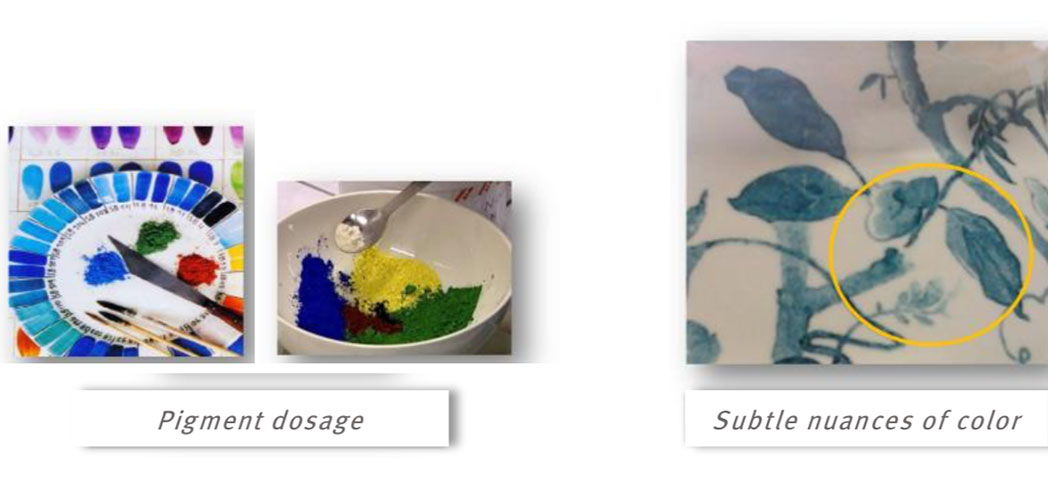
Product sorting standards
Each time our products are fired they are subsequently checked in our sorting workshop.They receive inspections at 3 different stages of production (biscuit, glazed, decorated) to check compliance with strict standards and precise specifications. This is to ensure premium quality. Sorting criteria factor in all features inherent to Gien production constraints to guarantee the best balance between the product's esthetic characteristics and production technique.
When the first check is conducted, on biscuit, any discarded pieces are set aside and ground, to be reutilized in clay paste. This is an integral part of our recipe and ensures rejects are salvaged and put to good use.
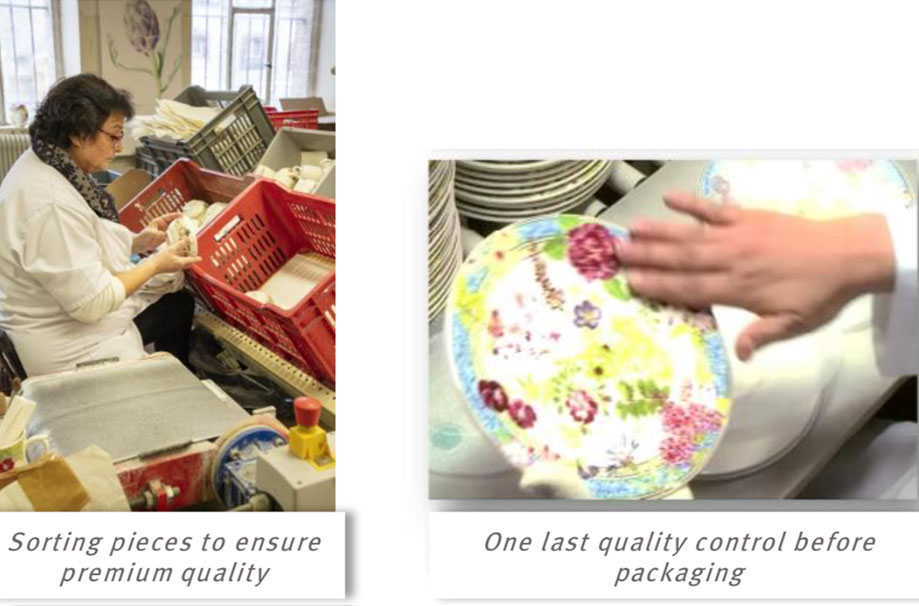
Conclusion
Faiencerie de Gien is anxious to keep to traditional production techniques that have built its reputation. Goods are hand made, in France, requiring many hours of work as well as acute attention to detail, to ensure the final product is perfect. A plate passes through the hands of 30 skilled craftsmen and women. Production is a long and intricate process that demands time, concentration and patience. Gien is the only French earthenware pottery to make its own clay paste, molds, glazes, pigments, etc. Our goods are 100% Made in Gien. So marks and traces from the making process are a testimony to the hands that have worked to produce each and every piece, to the skill and challenging requirements of the brand, in their production.
Glossary
Slip : clay paste diluted with water
Biscuit : earthenware that has been fired once and has no glaze
Calibrating : shaping clay paste with a sizing tool that is lowered onto on a spinning mold
Trimming : clay trimmings (handles, knobs) are put in place to complete the piece. These features are then hand painted.
Porous : a substance featuring a multitude of tiny holes, pores
Crazing : a web of small fine cracks in the glaze surface
Vitrified : transformed into glass, encased in a vitreous covering

